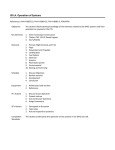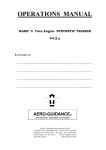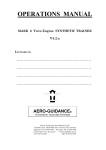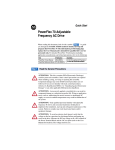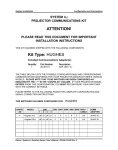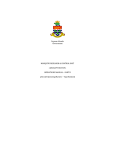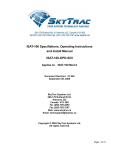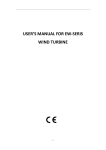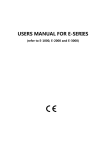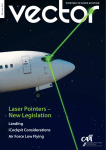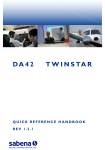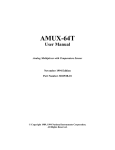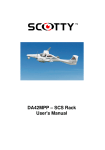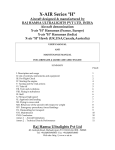Download Here you`ll find a brief PDF sample of our lesson plan e
Transcript
Here you’ll find a brief PDF sample of our lesson plan e-books and how they work. Right click and select ‘Save As…’ or use the Save option provided on the screen. Follow the instructions on the next page to use the navigation features in Adobe Acrobat or with GoodReader on your iPad. 1 PDF INSTRUCTIONS ADOBE ACROBAT NAVIGATION PANE Click View, select Navigation Bars, and click Bookmarks. TABLE OF CONTENTS (Page 3) The lesson plans listed in the Contents page (below) can be clicked on for easy navigation. LINKS Blue text in the body of a lesson (not the heading/header) is a web link (it may not always be underlined). Clicking on the text will take you to a website for more information. For example: The Backseat Pilot GOODREADER DOWNLOADING THE E-BOOK 1. Access the link to download the lesson plans on your iPad either from the email we sent you or your account on our website. Rather than clicking on the link, press and hold, then select ‘Copy Link’ 2. Open GoodReader, and tap the connect button (on the home screen - it’s the second button from the right on the top row of buttons) 3. Tap the ‘Enter URL’ button (directly below the Connect button) 4. Press and hold on the text box, then select Paste (this will paste the download link you copied in step 1) 5. Press OK. Once complete you should be able to access the lesson plans in the Downloads folder 6. You can move or rename the file by pressing and holding the lesson plan document, then selecting Move, Rename, etc. from the various options that appear There are other ways to get the document into GoodReader. The easiest way to access these is to tap the Help button (from the GoodReader home page - bottom row of buttons, in the middle), press How-Tos, and select Transfer files to/from GoodReader. NAVIGATION PANE Once the document is open, a single tap anywhere on the document will open the various toolbars as well as the tabs depicting the open document(s). Tapping the open book image on the bottom toolbar (in the middle) opens the Outline, or Content links, that can be used to access individual lessons immediately without scrolling through the entire document. CONTACT If you come across any errors, need your downloads reset, or have any questions please contact us at [email protected], or head to our website and send us a contact form (they both go to the same inbox). THE BACKSEAT PILOT - TERMS AND CONDITIONS All The Backseat Pilot lessons are for your personal (one user) use, copies may not be provided to others. These lessons may not be shared or claimed as your own, and may not be used to create products for sharing or selling. Thank you for your honesty. All lessons are © 2011 The Backseat Pilot 2 Contents III. Preflight Preparation III.C. Operation of Systems .................................................................................................................... 5 XIII. Emergency Operations XIII.C. Engine Failure after Lift-Off .................................................................................................... 15 Thank You! Let us know what you think .................................................................................................................. 21 3 III. Preflight Preparation 4 III.C. Operation of Systems References: FAA-H-8083-23; FAA-H-8083-25; FAA-H-8083-3; POH/AFM Objectives The student should develop knowledge of the elements related to the DA42 systems and their operation as required in the PTS. Key Elements 1. Semi-monocoque Construction 2. Thielert TAE 125-01 Diesel Engines 3. ECU’s/FADEC Elements 1. 2. 3. 4. 5. 6. 7. 8. 9. 10. Primary Flight Controls and Trim Flaps Powerplant and Propeller Landing Gear Fuel System Electrical Avionics Pitot Static, Vacuum Pressure, and Associated Flight Instruments Environmental Deicing and Anti-Icing Schedule 1. 2. 3. 4. Discuss Objectives Review material Development Conclusion Equipment 1. White board and markers 2. References IP’s Actions 1. 2. 3. 4. SP’s Actions 1. Participate in discussion 2. Take notes 3. Ask and respond to questions Completion Standards The student understands the operation of the systems in the DA42 aircraft. Discuss lesson objectives Present Lecture Ask and Answer Questions Assign homework 5 III.C. Operation of Systems Instructor Notes: Introduction: Attention Interesting fact or attention grabbing story The inner workings of the airplane; to develop a better understanding of what is what, and what is where. Overview Review Objectives and Elements/Key ideas What The main systems found on the DA42. This includes the primary flight controls and trim, flaps, powerplant, propeller, landing gear, fuel, oil and hydraulic systems, electrical and avionics systems, flight instruments and the environmental system. Why Understanding how the airplane works internally will allow for better troubleshooting and problem identification. The pilot will have a better understanding of the airplane as a whole and the ability to make a more competent go/no go decision. How: 1. Primary Flight Controls and Trim A. Ailerons i. Glass Fiber Reinforced Plastic/Carbon FRP Sandwich ii. Actuated via push rods iii. Attached with stainless steel and aluminum hinges B. Elevator (GFRP) i. Actuated via push rods ii. Semi-Monocoque sandwich construction iii. Trim a. Mechanical (wheel on center console) & Electrical (rocker switch) Systems b. Two actuating Levers Left Lever a Connects to long flexible cable that is adjusted by the pilot to adjust trim Right Lever a Friction Damper to prevent fluttering if mechanical failure of the trim cable iv. Variable Elevator Stop a. Limits elevator up movement when: Both engines exceed 20%, AND Flaps are set to landing b. Used to prevent over rotation during a go around Apparently there was an excessive left turning tendency they wanted to limit C. Rudder i. Actuated via control cables ii. Trim a. Controlled with black wheel on center console Flexible cable connects it to trim tab 6 III.C. Operation of Systems iii. Semi-Monocoque sandwich construction 2. Flaps A. GFRP/CFRP Sandwich B. 2 section construction i. Outer Flap: 6 hinges ii. Inner Flap: 4 hinges iii. Each section has its own push rod (4 total) iv. Fail Safe Construction: Inner & outer are connected which prevents a split flap condition a. If one push rod breaks on either side all flaps will still deploy (no split flap) C. Driven by an electric motor i. Electric flap actuator is protected by a circuit breaker (5 Amp) a. Located on the R side of the instrument panel and can be manually tripped to disable the system D. Controlled by 3 position flap operating switch on the instrument panel i. Top position – Up – 0o (Green Light) ii. Middle Position – Cruise – 20o (Yellow Light) - 137 knots iii. Bottom Position – Landing – 42o (Yellow Light) -111 knots iv. When two lights are illuminated at the same time, the flaps are in-between positions 3. Powerplant and Propeller A. Powerplant i. Thielert Diesel TAE 125-01 engines a. 135 hp @ 2300 rpm b. 4 cylinder c. 4 stroke d. Liquid Cooled e. Turbocharged f. Reduction gear to Propeller g. Wet Sump Oil system ii. Diesel Engine a. Typically turbocharged to ensure compression/temperatures in combustion chamber No spark plugs, air/fuel mixture combusts due to high pressure and temperature b. Diesel/Jet A fuel contains more energy than avgas More fuel efficient/cleaner iii. Common Rail Injection a. High pressure reservoir of fuel which feeds injectors iv. Turbocharged a. Ensures air is properly compressed for combustion Air is compressed in the compressor, then sent to the intercooler a Intercooler cools the hot compressed air 1. Cooling further compresses the air for more power Then it is sent to the combustion chambers The exhaust is ducted back to spin the compressor b. Compressor Engine exhaust air is used to run the compressor Wastegate a Gate that opens or closes to allow more of less exhaust gas to run the compressor 1. More air = More compression 2. Less air = Less Compression 7 III.C. Operation of Systems b Adjusts to maintain engine manifold pressure based on altitude B. Propeller i. General a. Wood covered in GFRP b. Constant Speed, Fully Feathering ii. Gearbox a. Ratio of 1.69:1 Engine spins 1.69 rpm to every 1 prop rpm b. Gearbox has its own oil system (separate from engine) iii. Constant Speed Unit (CSU) a. Since there’s no RPM lever the CSU adjusts prop pitch for you b. Oil pressure is used to move a piston which in turn adjusts the pitch of the blades Increasing oil pressure = more fine pitch (flatter blade angle) Decreasing oil pressure= higher pitch If oil pressure is lost the props will auto feather a This happens only when RPM is > 1300 b If below 1300 RPM (like on normal shutdown) the Coarse Pitch Stop will prevent feathering 1. Props won’t feather on normal shutdown iv. Accumulator a. Stores pressure at 290 psi (nitrogen and oil charge) Uses pressure to unfeather prop when restarting in air Maintaining RPM as engine slows a To keep a constant rpm as engine slows (in a climb, etc.) the blade angle needs to get finer (more oil pressure is needed on piston). If it cannot accomplish this under normal circumstances the accumulator will use its stored oil pressure to further decrease blade angle C. Engine Cooling i. Water based with antifreeze ii. Two circuit system a. Main circuit cools engine b. Bypass circuit for when engine temperature is cold D. Engine Control Unit i. Heart of the FADEC – Monitors, controls and regulates all important parameters ii. 2 ECU’s per engine, an A & B ECU a. A is used for normal operation, B is backup iii. Electrically powered a. Electricity is necessary to run engines iv. Redundant a. Both ECUs are always operational, only one is active If A is not 100% it auto switches to B E. Engine Master Switches i. Powers a. Engine ECUs b. Engine Preheat (flow plugs) c. Unfeathering Accumulator d. Enables starter 8 III.C. Operation of Systems e. Connects alternators to excitation batteries F. Oil System i. One oil system for the engine, one for propeller gear box ii. Engine Oil = Wet Sump System a. Means engine oil is stored in the engine b. Dry sump = oil reservoir is outside of the engine and pumped in G. Alternate Air i. Air is drawn from engine compartment ii. One lever opens alternate air for both engines 4. Landing Gear A. General i. Fully retractable, Hydraulically operated, Electrically powered B. Main Gear i. Trailing Link Design ii. Tubular strut with a trailing link at the bottom a. Wheel attaches to trailing link b. Gas/Oil filled damper attaches to rear of tubular steel strut and trailing link C. Nose Gear i. Steel strut w gas/oil damper to absorb shock ii. Steering a. Obtained by rudder control via steering linkage b. Spring assembly centers gear when deflected Nose wheel retracts straight after takeoff D. Hydraulic Supply & Control i. Hydraulic Control Block a. Electric Motor b. Hydraulic Pump and Pressure Switch Pumps hydraulic pressure to extend/retract gear Pressure switch maintains pressure in system a Turns on at 1400 psi and off at 1650 psi c. Hydraulic Reservoir Stores excess hydraulic fluid d. Hydraulic Accumulator E. Gear Operation i. System is always pressurized ii. Electrically operated valves provide hydraulic pressure to move actuators iii. Main gear retracts inboard, Nose gear retracts forward iv. Hydraulic pressure on actuators keeps gear retracted a. No up locks, if hydraulic pressure fails, gear will extend v. If electrical system fails, gear will extend automatically a. Hydraulic pressure will fail without electric power F. Emergency Extension i. Releases hydraulic pressure allowing gear to fall by gravity G. Safety Features i. Squat Switch a. Left main gear leg Prevents gear from retracting on ground 9 III.C. Operation of Systems ii. Gear Warning Horn a. Either power lever below 25%, or b. Flaps in Landing Position H. Wheel Brakes i. Hydraulically operated disc brakes ii. Operated individually using toe-brake pedals iii. Failure a. If either the left or right wheel brake system on the pilot’s side fail, the co-pilot’s brakes fail too b. If copilot’s master brake cylinder/input lines to the pilot’s master cylinder fail the pilot’s brakes will stop operate I. Parking Brake i. Repeated pushing of the toe-brake pedals will build up the required brake pressure, which will remain in effect until the brake is released 5. Fuel System A. Fuel i. 2 main aluminum fuel tanks a. Each tank has 3 chambers joined by hoses b. 25 gallons per tank ii. Auxiliary Tanks a. 2 (optional) 13.2 useable gallon tanks 26.4 Gallons total + 50 Gallon mains= 76.4 useable gallons b. Located in rear of engine nacelle c. Fuel is transferred from Aux to main tanks via pump switch on rear center console iii. Components a. Fuel Selector Each engine has one Settings a On – Normal fuel flow b X-Feed – Engine draws fuel from opposite fuel tank c Off – Turns off fuel to engine b. Indicators Inner and Outer chamber of main fuel tanks have level sensors a Not necessary to have one in middle chamber Low level sensor a Operates at 3-4 USG in tank c. Fuel Cooler Uses heat exchanger to cool fuel before returning it to tank 2-3 times more fuel than is necessary for injectors flows through common rail a Common rail is under tremendous pressure so fuel gets very hot b Excess fuel is returned to engine, but cooled first 1. Prevents vapor lock iv. Operation a. 2 fuel pumps Booster Pump a Sends fuel to high pressure pump High Pressure Pump 10 III.C. Operation of Systems a Pumps fuel to common rail b. Normal Operation Fuel is drawn from tank into engine, the unused fuel is returned to the tank via fuel cooler c. X-Feed Fuel is drawn from opposite tank into engine, unused fuel is returned to original tank a Prevents over filling the opposite tank 6. Electrical A. Power Generation i. Two 28V DC, 60 Amp Alternators ii. Belt drive, located on bottom left of each engine iii. Controlled by separate on/off switches on instrument panel Alternator can never actually be turned off, just disconnected from system a Alternator is directly connected to ECU buses, always want power to ECUs iv. Alternator Control Unit a. Balances load between the two alternators based on temperature Colder alternator gets more load v. Excitation Batteries a. Two 12 V, 1.3 amp-hr. lead acid batteries b. Used to get alternators started c. Also used to sustain the alternator if it cannot generate a magnetic field B. Power Storage i. Main Battery a. 24 V, 10 A-hr., lead acid battery b. Located rear-right side of front baggage compartment ii. Emergency Power Pack a. 10 non rechargeable dry lithium manganese batteries b. 3 V, 1300 mA-hr. c. Runs backup AI and flood light for at least 1.5 hrs. In the case of electrical failure and main battery failure d. Controlled by emergency switch iii. ECU Backup Batteries a. In the case of total electrical failure the ECU backup batteries will provide power to the ECUs to keep the engines running C. Power Distribution i. Main Battery connects to Battery bus a. Battery bus connects to LH/RH main bus ii. LH Main Bus a. Connects to L Alternator b. LH ECU Bus iii. RH Main Bus a. Connects to R Alternator b. RH ECU Bus c. Avionic Bus 7. Avionics A. G1000 i. G1000 info can be found in the user’s manual B. PFD i. Contains primary instruments 11 III.C. Operation of Systems C. MFD i. Navigation and Engine instruments 8. Pitot-static, Vacuum Pressure, and Associated Flight Instruments A. Pitot-Static i. Pitot pressure is measured on the leading edge of a calibrated probe below the left wing ii. Static pressure is measured by the same probe iii. Instruments a. G1000 takes input from the pitot & static pressure probe and converts it digitally 9. Environmental A. Cabin Heat and Defrost i. Cabin Heat is ducted from heat exchanger in the right engine nacelle ii. Defrost is ducted from heat exchanger in the left engine nacelle 10. Deicing and Anti-Icing A. General i. Weeping wing protection a. Distributes a thin film of deicing fluid over wing, vertical stabilizer, horizontal stabilizer, propeller, and canopy ii. Components a. Tank Holds 7.9 Gallons Low level sensor (45 min) Located in Nose b. Pumps 2 main pumps a Used for Wings, Stabilizers and Props 2 Windshield pumps iii. Modes a. Normal Operates with switch to Norm Both main pumps operated simultaneously Use prior to accumulation Pumps cycle: On for 30 sec, Off for 90 sec Max Duration: 2.5 hrs. b. High Operates with switch to High One pump runs continuously Use when ice has accumulated Max Duration: 1 hr. c. Max Operates by Max button Both pumps run continuously Used in severe icing conditions Runs both pumps for two minutes Max duration 30 min iv. Windshield Push Button a. Activates selected pump for 5 seconds (even if main system switch is off) v. Alternate Switch 12 III.C. Operation of Systems a. If LH Main Bus is lost (Ice system is on LH Main Bus) Flip Alternate switch to connect system to RH main bus a Operation only works in high mode Conclusion: Brief review of the main points A thorough understanding of the airplane’s systems makes a safer, smarter pilot. PTS Requirements: To determine that the applicant exhibits instructional knowledge of the elements related to the operation of systems, as applicable to the airplane used for the practical test, by describing the following systems: 1. Primary and secondary flight controls 2. Trim 3. Water rudders (AMES) 4. Powerplant and propeller 5. Landing gear 6. Fuel, oil, and hydraulic 7. Electrical 8. Avionics including autopilot 9. Pitot static, vacuum/pressure and associated instruments 10. Environmental 11. Deicing and anti-icing 13 XIII. Emergency Operations 14 XIII.C. Engine Failure after Lift-Off References: FAA-H-8083-3; POH/AFM Objectives The student should develop knowledge of the elements related to handling an engine failure while airborne. Key Elements 1. Fly First 2. Zero Side Slip 3. Don’t approach VMC Elements 1. Maintaining Aircraft Control after an Engine Failure 2. Engine Failure After Lift Off Schedule 1. 2. 3. 4. Equipment 1. White board and markers 2. References IP’s Actions 1. 2. 3. 4. SP’s Actions 1. Participate in discussion 2. Take notes 3. Ask and respond to questions Completion Standards The student can safely maintain control of the aircraft and properly handle the checklists in the event of an engine failure while airborne. Discuss Objectives Review material Development Conclusion Discuss lesson objectives Present Lecture Ask and Answer Questions Assign homework 15 XIII.C. Engine Failure after Lift-Off Instructor Notes: Introduction: Attention Interesting fact or attention grabbing story Overview Review Objectives and Elements/Key ideas What This lesson will cover the elements involved with safely handling an engine failure while airborne, whether that includes landing on the remaining runway, returning to land, or enroute. Why In the case of an engine failure it is essential that a pilot understands the elements involved and can maintain control of the airplane. How: 1. Maintaining Aircraft Control after an Engine Failure A. Recognize the Engine Failure and Maintain Directional Control i. The easiest way to recognize an engine failure is visually(if in VMC) a. The pilot will recognize an uncommanded yaw in the direction of the dead engine b. Visual recognition allows for better control, don’t stare at the engine instruments, fly the plane c. If in IMC, the engine failure will be recognized on the instruments, the aircraft will yaw toward the dead engine, the nose will drop, engine gauges will indicate a failure d. CE – Failure to recognize an inoperative engine ii. When an engine fails use rudder and aileron to maintain directional control a. Establish a zero sideslip configuration by adding approximately 2-3o of bank to counteract the roll and maintaining heading visually with rudder pressure (the aircraft will almost fall into a sideslip) After a couple degrees of bank are established and rudder pressure is set to maintain heading double check the zero sideslip on the instruments and make changes needed a A zero sideslip will vary based on the aircraft flown, but 1-3o bank toward the operating engine and ½ ball deflection (on the turn coordinator) toward the operating engine should be close b. CE – Failure to establish and maintain proper bank for best performance Additional bank or too little bank will create excess drag on the airframe (since it is no longer coordinated), thus reducing performance B. Set the Controls (Full Power) i. Initially this means add full power on both engines a. Increasing power means increasing rudder b. The more power, the more yaw created, don’t increase the power and lose control of heading c. Smoothly increase the power and rudder pressure (fast movements are hard to control) C. Reduce Drag i. Verify Gear and Flaps are UP ii. CE – Failure to properly adjust engine controls and reduce drag 16 XIII.C. Engine Failure after Lift-Off a. Full power is necessary due to the loss of an engine b. Reducing drag is necessary to prevent altitude loss c. In an engine failure always add full power and reduce drag immediately Unless landing straight ahead Maintain control of the aircraft, add right rudder with the increase in power D. Identify i. Dead Foot, Dead Engine a. Whichever foot is not being used on the rudder correlates to the engine that has failed If the right foot is “dead” on the ground, the right engine is the failed engine E. Verify i. To verify, reduce the throttle for the dead engine to idle a. There should be no change You’ll know if you got the wrong throttle when the aircraft yaws rapidly in the wrong direction b. Reduce the throttle gently, if you accidentally got the wrong engine it will be easier to maintain control (again, fast movements are hard to control) ii. CE – Hazards of improperly identifying and verifying the inoperative engine a. Choosing the wrong engine can be very dangerous b. One engine is already failed, if you feather the incorrect engine (because you skipped or didn’t properly identify/verify the failed engine) you will be in a situation with zero engines operating F. Fix or Feather i. If there is time and altitude attempt to fix the failed engine a. Follow manufacturer procedures CE - Failure to follow prescribed emergency checklist b. Take a break from the checklist every step or two to check airspeed, altitude, heading, zero sideslip and engine instruments There’s no rush to getting the checklist done, flying is most important ii. If it cannot be fixed (or if time does not allow it) then feather the engine a. Follow manufacturer procedures CE - Failure to follow prescribed emergency checklist b. Take a break from the checklist every step or two to check airspeed, altitude, heading, zero sideslip and engine instruments There’s no rush to getting the checklist done, flying is most important iii. Before feathering the engine ALWAYS verify you have the correct engine iv. When feathered rudder can be reduced a. Yaw toward the dead engine is reduced since the drag on the inoperative propeller is reduced b. Adjust the controls to maintain the zero sideslip G. Restart the Inoperative Engine i. Follow manufacturer Procedures a. CE - Failure to follow prescribed emergency checklist ii. Maintain control during the process a. When the engine restarts rudder will have to be increased as yaw and drag will increase iii. As you increase the power, adjust rudder a. Maintain directional control with the rudder/aileron visually H. Overview: Maintain control, full power, gear up, flaps up, identify, verify, fix or feather 2. Engine Failure After Lift-Off A. Engine failures after lift-off can be summarized into four scenarios 17 XIII.C. Engine Failure after Lift-Off B. C. D. E. i. Landing Gear Down ii. Landing Gear Up, single engine climb inadequate iii. Landing Gear Up, single engine climb adequate iv. Enroute (at a safe altitude) Engine Failure After Lift-Off with the Gear Down i. A takeoff or go around is the most critical time to suffer an engine loss a. The airplane will be slow, close to the ground and flaps and gear may be extended b. Altitude and time will be minimal ii. If failure occurs before selecting the gear up, close both throttles and land on the remaining runway a. Landing gear should be retracted when a positive rate of climb is established AND no remaining runway is available to land on Therefore, if the landing gear is up the decision has been made to continue the flight if an engine fails Landing gear up, single engine climb inadequate i. A landing must be accomplished on whatever lies ahead a. Maintain control, clean up excess drag, establish zero side slip, pitch for VYSE ii. A descent at VYSE can increase the distance the aircraft can fly before reaching the ground iii. If necessary (and better than landing gear up), lower the gear for landing Landing Gear Up, single engine climb adequate i. The procedures for continued flight should be followed a Control 1. Use rudder and aileron as necessary in order to maintain control/zero side slip a. CE - Failure to establish and maintain proper bank for best performance 2. Fly the plane first, checklists second b Configuration - Full Power, Gear, Flaps, Identify (dead foot, dead engine), Verify (reduce throttle), Fix or Feather 1. CE – Failure to properly identify and verify the inoperative engine 2. CE – Failure to properly adjust engine controls and reduce drag c Perform the appropriate checklist 1. CE – failure to follow prescribed emergency checklist 2. Do not attempt to fix the failed engine unless time and altitude allow d Maintain VYSE 1. CE – Failure to establish and maintain a pitch attitude that will result in best engine inoperative airspeed, considering the height of obstructions e Return to land Enroute i. The procedures for continued flight should be followed a. Control Use rudder and aileron as necessary in order to maintain control/zero side slip Maintain altitude (if necessary climb at VYSE) a Pitch will have to increase in order to maintain altitude due to the lost engine Fly the plane first, checklists second b. Configuration - Full Power, Gear, Flaps, Identify (dead foot, dead engine), Verify (reduce throttle), Fix Follow the checklists to attempt to fix the engine a After every step or two return to flying the aircraft 1. Check altitude, airspeed, heading, zero sideslip, and engine indications 2. There’s NO rush to finish the checklist, controlling the aircraft is the #1 priority 18 XIII.C. Engine Failure after Lift-Off c. If the engine cannot be fixed proceed to feather the engine as described in the POH/emergency procedures and land as necessary Common Errors: Failure to follow prescribed emergency checklist Failure to properly identify and verify the inoperative engine Failure to properly adjust engine controls and reduce drag Failure to maintain directional control Failure to establish and maintain a pitch attitude that will result in best engine inoperative airspeed, considering the height of obstructions Failure to establish and maintain proper bank for best performance Conclusion: Brief review of the main points Control is the most important aspect of any engine failure. No matter where the engine failure occurs, maintain control before, during and after any checklists are completed. PTS Requirements: To determine that the applicant: 1. Exhibits instructional knowledge of the elements related to engine failure after lift-off by describing: a. Use of prescribed emergency checklist to verify accomplishment of procedures for securing the inoperative engine. b. Proper adjustment of engine controls, reduction of drag, and identification and verification of the inoperative engine. c. How to establish and maintain a pitch attitude that will result in the best engine inoperative airspeed, considering the height of obstructions. d. How to establish and maintain a bank as required for best performance. e. How to maintain directional control. f. Methods to be used for determining reason for malfunction. g. Monitoring and proper use of the operating engine. h. An emergency approach and landing, if a climb or level flight is not within the airplane’s performance capability. i. Positive airplane control. j. How to obtain assistance from the appropriate facility. 2. Exhibits instructional knowledge of common errors related to engine failure after lift-off by describing: a. Failure to follow prescribed emergency checklist. b. Failure to properly identify and verify the inoperative engine. c. Failure to properly adjust engine controls and reduce drag. d. Failure to maintain directional control. e. Failure to establish and maintain a pitch attitude that will result in best engine inoperative airspeed, considering the height of obstructions. f. Failure to establish and maintain proper bank for best performance. 3. Demonstrates and simultaneously explains a simulated engine failure after lift-off from an instructional standpoint. 4. Analyzes and corrects simulated common errors related to engine failure after lift-off. 19 Thank You! 20 Let us know what you think Thanks for taking the time to check out our lessons! We welcome any feedback you may have to help us make them more useful. Don’t hesitate to send us an email ([email protected]), or contact us from the website with any questions or comments you may have. 21





















